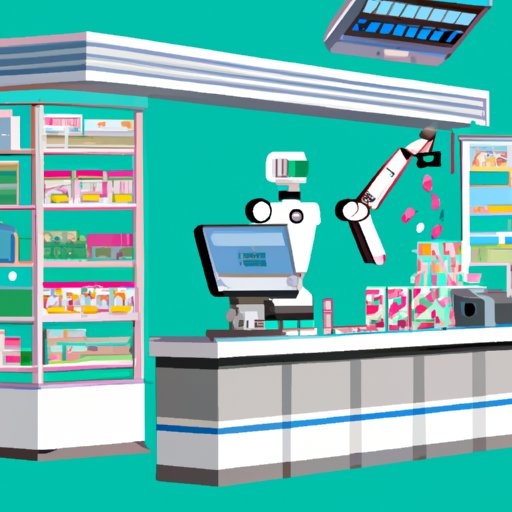Introduction
Pharmacy automation is the use of technology to automate various processes within a pharmacy, with the aim of increasing accuracy, reducing costs and improving efficiency. Automated systems may include automated dispensing cabinets, robotics, artificial intelligence, barcode systems and more. In this article, we will explore the pros and cons of implementing pharmacy automation, examine a case study of its adoption in a hospital setting, look at the latest advances in pharmacy automation technology, and consider the impact on drug safety and patient outcomes.

Examining the Pros and Cons of Implementing Pharmacy Automation
When considering the implementation of pharmacy automation, there are several factors that must be taken into account. One of the main advantages of automated systems is increased efficiency. Automated systems can help pharmacies manage their workflow more efficiently, allowing them to process orders and dispense medications faster and more accurately. This can lead to improved patient satisfaction, as well as reduced wait times for customers.
In addition to improved efficiency, pharmacy automation can also lead to cost savings. Automated systems can eliminate the need for manual labor, which can help reduce overhead costs. Automated systems can also help reduce waste by streamlining inventory management and ensuring that medications are stored and dispensed correctly.
While there are many potential benefits to implementing pharmacy automation, there are also some potential drawbacks. Automated systems require a significant upfront investment and may require additional training for staff members. In addition, some automated systems may be more prone to errors than manual systems, and they may not be able to detect certain types of medication errors.
Case Study: Adoption of Pharmacy Automation in a Hospital Setting
To better understand the potential benefits of pharmacy automation, let’s look at a case study of its adoption in a hospital setting. The case study involved a large hospital in the United States that implemented an automated dispensing cabinet (ADC) system. The system was designed to help reduce medication errors, improve efficiency, and reduce the amount of time needed to complete pharmacy tasks.
The ADC system was integrated into the hospital’s existing pharmacy workflows. This allowed staff members to access medications quickly and accurately, without having to manually search for them. In addition, the system allowed for improved inventory management, as it tracked the number of medications in stock and the expiration dates of each medication.
The results of the ADC system implementation were positive. Medication errors were reduced, and staff members were able to complete pharmacy tasks in a shorter amount of time. In addition, the hospital was able to save money on labor costs due to the increased efficiency of the system.

Exploring the Latest Advances in Pharmacy Automation Technology
As technology continues to advance, pharmacy automation systems are becoming increasingly sophisticated. Automated dispensing cabinets (ADCs) are one of the most common types of automated systems used in pharmacies. ADCs are typically wall-mounted units that store medications and allow pharmacists to quickly and accurately dispense medications. They can also be used to track inventory and monitor expiration dates.
Robotics and artificial intelligence (AI) are two other technologies that are being used to improve pharmacy automation. Robotics can be used to automate mundane tasks such as stocking shelves and filling prescriptions. AI can be used to analyze data and provide insights into patient care, medication adherence, and more. AI-powered chatbots can also be used to provide personalized customer service.
Barcode systems are another type of automated system that is becoming increasingly popular in pharmacies. Barcode scanners can be used to quickly identify and track medications, reducing the risk of errors and improving accuracy. Barcode systems can also be used to verify patient information and ensure proper dosing.

The Impact of Pharmacy Automation on Drug Safety and Patient Outcomes
One of the main benefits of pharmacy automation is improved accuracy. Automated systems can help reduce the risk of medication errors by eliminating the need for manual input. Automated systems can also help ensure that medications are dispensed correctly, which can help reduce the risk of adverse drug reactions and other complications.
Automated systems can also help improve medication adherence by providing reminders and notifications to patients. This can help ensure that patients take their medications as prescribed, which can lead to improved outcomes. Finally, automated systems can help pharmacies track inventory and monitor expiration dates, which can help reduce waste and ensure that medications are always available when needed.
Conclusion
In conclusion, pharmacy automation offers numerous benefits, including increased efficiency, cost savings, improved accuracy and reduced medication errors. Automated systems can also help improve drug safety and patient outcomes by ensuring that medications are dispensed correctly and helping patients adhere to their treatment plans. The latest advances in pharmacy automation technology are making these systems even more powerful and effective, and they are likely to become even more widespread in the future.
(Note: Is this article not meeting your expectations? Do you have knowledge or insights to share? Unlock new opportunities and expand your reach by joining our authors team. Click Registration to join us and share your expertise with our readers.)
